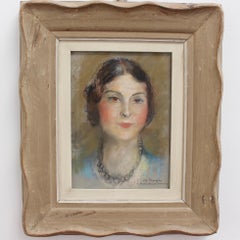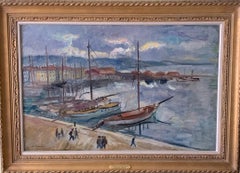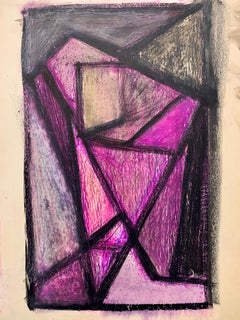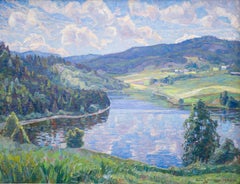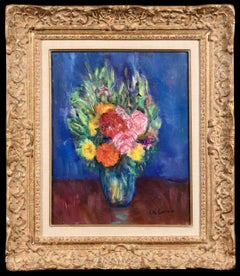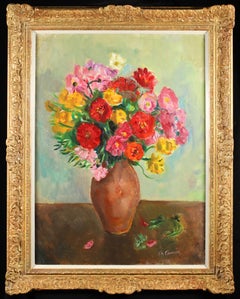Pastel on paper circa 1940 by Charles Camoin depicting a Provencial landscape with the tree to right and a cottage behind set in fields. There are further ink studies on the reverse of this work of elegant women. Signed lower left. Framed dimensions are 11.50 inches high by 14 inches wide.
Provenance:
Private French collection
Charles Camoin was the son of a paint manufacturer in Marseilles who died when Charles was six years old. His mother travelled extensively, absenting herself for long periods at a time, and Camoin's studies suffered accordingly. At 16, he enrolled at a commercial college in Marseilles, but also attended courses at the École des Beaux-Arts, where he was awarded a first prize for drawing and composition. In 1896, at the age of 17 (or in 1898 according to other, possibly more reliable sources), Camoin moved to Paris where he was admitted to Gustave Moreau's class at the École des Beaux-Arts, shortly before the latter's death. He soon left on his travels in the company of Albert Marquet - no doubt following Moreau's advice to 'go and paint buses', his recommendation to the two artists to search out their subject matter on the streets and in the cabarets of Paris. During his short time in Moreau's class Camoin made a number of lasting friendships, notably with artists who would go on to pioneer Fauvism: Henry Manguin, Georges Roualt and, in particular, Jean Puy and Henri Matisse, with whom he exchanged letters on a regular basis.In 1900, Camoin did his military service, first in Arles, where he painted compositions inspired by Van Gogh motifs, then in 1902 in Aix, where he frequently met with Cézanne, with whom Camoin maintained a life-long correspondence and whose advice and counsel he cited repeatedly. In 1903, Camoin exhibited for the first time - at the Salon des Artistes Indépendants in Paris. The following year (1905), he met Claude Monet (at Cézanne's instigation and, appropriately perhaps, underneath Giverny's Nympheas); he then held his first solo exhibition at the Berthe Weill Gallery in Paris. In 1905, Camoin exhibited alongside the 'Animals' at that year's Salon d'Automne, although it must be said that he did not share the graphic and chromatic violence of a Matisse or a Derain, preferring as he did to adhere to a more Cézanne-like approach. The following decade saw Camoin travelling extensively in the company of Marquet, visiting London, Frankfurt, Naples, Capri, Corsica, the Mediterranean coast, Tangier and Morocco (where he was accompanied by Matisse). In 1912, Camoin exhibited at the Galerie Kahnweiler in Paris and, in 1913, examples of his work featured at the now legendary Armory Show in New York City. In 1918, Camoin and Matisse travelled to Cagnes to visit Renoir; the meeting was to prove decisive because it signalled the end of Cézanne's influence on Camoin's work. In 1920, at the age of 41, Camoin married Charlotte Prost; their daughter Anne-Marie was born in 1933. Camoin worked latterly out of two studios, the one in Montmartre that he had occupied since 1944, and the other in St. Tropez. He was made an officer of the Légion d'Honneur that same year and in 1959 he was elected Commander of the Ordre des Arts et Lettres. Camoin's early work was influenced by the Provence tradition: striking colours applied liberally in bold brushstrokes, to the point where some of his work ( Portrait of the Artist's Mother, Self-portrait in Uniform and Cabaret Artiste) were wrongly attributed to Paul Gauguin. After his travels from 1905 to 1915 in the company of Matisse and Marquet, a change of technique became apparent as Camoin began to focus more on light than on colour. In this respect, he and Marquet were as one, as their work dating from this period shows (in fact, Camoin's portrait of Marquet was long considered to be a Camoin self-portrait). Overall, his work from what might be considered his genuinely Fauve period is targeted very much towards the critical audience identified at the 1912 Kahnweiler Gallery exhibition and at the 1913 New York Armory Show. For some reason or other, his personal success at both exhibitions provoked some kind of depression in Camoin and he promptly destroyed more than 80 of his canvases. There has been considerable speculation as to the reasons which lay behind this depression, but it is difficult to explain it away on purely aesthetic/artistic grounds: that it was provoked by his association with the Fauves seems unlikely, given that he never fully espoused the Fauvist style, colours and technique. In the event, some of the paintings he opted to destroy were subsequently 'retrieved' by collectors, a fact which triggered a successful lawsuit in 1927 against Francis Carco and resulted in a benchmark decision to the effect that a painting which has been destroyed and thrown away may be recovered in its existing form but may not be subsequently 'restored' to its original form. In other words, the artist is and remains the sole arbiter. After visiting Renoir in 1918, Camoin became increasingly obsessed with light and the interplay of colours. As a result, he painted both in the studio and outdoors, directly from nature. His notebooks and journals document the difficulty he experienced in achieving a balance between the two, between as it were 'sensation' and 'construction'. In the event, he painted upwards of a hundred views of St-Tropez harbour as seen from his studio window, together with landscapes of the Var region he discovered while out walking. Camoin's productive life extended over half a century, from 1898 to 1964, but he painted little in the early years and his output while at the front during World War I consisted mainly of pastels and watercolours; equally, his output during World War II was also limited, due in part to the difficulty in obtaining materials. Nevertheless, outside those periods in his life, Camoin turned out by his own estimation some 50 canvases a year, which amounts to around 3,000 in total (of which roughly one-third were destroyed during his bout of depression). Nearly 700 of his paintings are housed in public and private collections. His output as an engraver was limited to some 30 plates as illustrations for various works. Camoin's output over the lengthy second period of his life was more restrained than in his Fauvist years. His sun-drenched landscapes full of flowers and peopled with attractive women and happy families on vacation are very much in tune with the overall hedonistic atmosphere that prevailed between the two world wars and which was typified by the 'poetic reality' of artists such as Legueult, Brianchon and Cavaillès. He showed his work on a regular basis at group exhibitions within the framework of the Salon d'Automne, Salon des Tuileries and Salon des Artistes Indépendants. In 1963, his work also featured in Marseilles at Gustave Moreau and his Pupils ( Gustave Moreau et ses élèves), where Camoin was the last surviving member of Moreau's atelier. During his lifetime, Camoin exhibited solo on some 30 occasions, including at the Weill and Kahnweiler galleries in 1904 and 1912 respectively and in retrospectives held at Rouen Museum (1931), Musée d'Art Moderne in Paris (1952), Chicago (1960) and New York City (1961). Posthumously, examples of Camoin's work featured in a number of major exhibitions devoted to Fauvism - in Tokyo (1965), Paris and Munich (1966) and Mechelen in 1969 - and in group exhibitions such as Going with the Flow: The Provencal School ( Au fil de l'eau. École Provençale) (Tapestry Museum, Aix-en-Provence, 2000) and Women in Provence and the Mediterranean ( Le Femme en Provence et en Méditerranée), an exhibition mounted in 2001 by the Fondation Regards de Provence at the Château de Borély in Marseilles. Posthumous solo exhibitions were held at the Musée des Beaux-Arts in Marseilles (1966), Palais de la Méditerranée in Nice (1971), Marcel Bernheim Gallery in Paris (1980), and the Cantini Museum in Marseilles in 1997. In 1955, Charles Camoin was awarded first prize at the Menton Biennale. Museum and Gallery Holdings Aix-en-Provence (Mus. Granet): Self-portrait in Infantryman's Uniform (1901); Bathers by a River (1912) Albi (Mus. Toulouse-Lautrec): Still-life (1947) Algiers (Mus. National des Beaux-Arts):
Portrait of Jenny...
